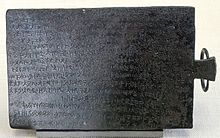Idalion (Kingdom)
Coordinates: 35 ° 0 '55.4 " N , 33 ° 25' 26.3" E
Idalion , Phoenician 'dyl (אדיל), ancient Greek Ιδάλιον , was an Iron Age kingdom on the Mediterranean island of Cyprus .
location
Idalion is located near today's Dali 15 km southeast of Nicosia near the copper deposits of the Troodos Mountains on the south bank of the Yialias . Topographically, the ancient settlement is located on two hills in the south of today's town, these are currently in the military UN buffer zone.
Building the city
The western hill with an acropolis and the remains of the royal palace have already been examined by American archaeologists, the buildings were assigned to the 5th and 4th centuries. Parts of the city wall and other building complexes were also exposed here. The wall remnants of the city fortifications examined were 10 meters thick, the former height of the city wall is said to have been over 8 meters. Information on the eastern Acropolis and the Lower City is still sparse.
Ancient mythological meaning
Aphrodite Idalia and her lover Adonis were especially venerated in Idalion . According to ancient mythology, Adonis was killed in the Idalion area by a boar sent by the jealous Ares . A rose or anemone grew out of the blood of the victim .
Digs
The first finds from the region were recovered by the American consul and robbery grave Luigi Palma di Cesnola in the years 1865 to 1876, he had become aware of an ancient burial ground on the outskirts and in his biography boasts more than 10,000 graves with rich offerings to have. Already Max Ohnefalsch judge had here excavations in Aphrodite performed Temple. The finds, mostly archaic statues and their limestone and terracotta remains are now in Berlin. In 1980, when a stable was demolished in Dali, more statues were found that might have been hidden here by Philipp Michaili, an excavation foreman of Ohnefalsch-Richter.
1970–1987 excavations took place here by the universities of UAlbany and Harvard . They were continued in 1987 under the direction of Pamela Gaber from the Oriental Institute in Chicago.
history

Since the 5th century BC BC and the Persian rule, the city was subject to the Kingdom of Kition or was in a permanent alliance with this. According to a bronze plaque found in Idalion, the city was besieged by the Medes and Citioners. This is usually done between 478 and 445 BC. BC or later. Pumjaton carried the title "King of Kitium and Idalion" ( mlk kty w'dyl ).
literature
- Pawel Flourentzos: A Group of Sculptures from Idalion . In: Paul Åström and Dietrich Sürenhagen (eds.): Periplus, Festschrift for Hans-Günter Buchholz on his eightieth birthday on December 24, 1999 (= Studies in Mediterranean Archeology 127). Jonsered 1999, p. 59ff.
- Maria Hadjicosti: The Kingdom of Idalion in the Light of New Evidence. The City-Kingdoms of Early Iron Age Cyprus in Their Eastern Mediterranean Context . In: Bulletin of the American Schools of Oriental Research . Volume 308, 1997, pp. 49-63.
- Franz Georg Maier : Factoids in ancient History: The case of Fifth-Century Cyprus . In: Journal of Hellenic Studies . Volume 105, 1985.
- Kyriakos Nicolaou: Idalion Cyprus . In: Richard Stillwell et al. a. (Ed.): The Princeton Encyclopedia of Classical Sites. Princeton University Press, Princeton NJ 1976, ISBN 0-691-03542-3 .
- Lawrence E. Stager / Anita M. Walker: American expedition to Idalion, Cyprus 1973-1980 . In: Oriental Institute Communications . Volume 24. The Oriental Institute of the University of Chicago, Chicago 1989. ( online )
- Lawrence E. Stager / Anita Walker / G. Ernest Wright (Ed.): American Expedition to Idalion, Cyprus, First Preliminary Report: Seasons of 1971 and 1972 . Bulletin of the American Schools of Oriental Research. Supplement 18. Cambridge 1974.
- Javier Teixidor: The Phoenician Inscriptions of the Cesnola Collection . In: Metropolitan Museum Journal . Volume 11, 1976, pp. 55-70.
- Andreas Schneider: Cyprus , DuMont Reiseverlag, Cologne 1988, ISBN = 3-7701-1857-X (DuMont art travel guide), p. 145
Web links
Notes and sources
- ↑ Areas released for inspection are marked with signs.
